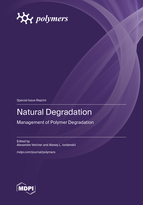Natural Degradation: Management of Polymer Degradation
A special issue of Polymers (ISSN 2073-4360). This special issue belongs to the section "Circular and Green Polymer Science".
Deadline for manuscript submissions: closed (25 August 2023) | Viewed by 23503
Special Issue Editors
Interests: biophysics; bionanotechnology; bioinformatics; thermodynamics; AFM; TEM; SEM
Special Issues, Collections and Topics in MDPI journals
Interests: biodegradable polymers; transport phenomena; electrospun fibers; controlled release; polymer blends; composites; water in macromolecular systems; sorption; gas permeability
Special Issues, Collections and Topics in MDPI journals
Special Issue Information
Dear Colleagues,
The rapid development of polymer science has brought convenience to people's lives. At the same time, more and more waste is produced from the use of polymer products, which causes harm to the environment. In order to protect the living environment, scholars have researched and developed the recycling technology of waste plastics. On the other hand, a lot of contemporary medicines contain polymers as a component, so a detailed study of the decay of such polymers, at least to their exit from the body, is required.
The issue is devoted to the different ways of polymers natural decay. Biodegradation is considered the core subject, but data on the action of water, oxygen, ozone, and UV/Vis light are also included.
Dr. Alexandre Vetcher
Prof. Dr. Alexey Iordanskii
Guest Editors
Manuscript Submission Information
Manuscripts should be submitted online at www.mdpi.com by registering and logging in to this website. Once you are registered, click here to go to the submission form. Manuscripts can be submitted until the deadline. All submissions that pass pre-check are peer-reviewed. Accepted papers will be published continuously in the journal (as soon as accepted) and will be listed together on the special issue website. Research articles, review articles as well as short communications are invited. For planned papers, a title and short abstract (about 100 words) can be sent to the Editorial Office for announcement on this website.
Submitted manuscripts should not have been published previously, nor be under consideration for publication elsewhere (except conference proceedings papers). All manuscripts are thoroughly refereed through a single-blind peer-review process. A guide for authors and other relevant information for submission of manuscripts is available on the Instructions for Authors page. Polymers is an international peer-reviewed open access semimonthly journal published by MDPI.
Please visit the Instructions for Authors page before submitting a manuscript. The Article Processing Charge (APC) for publication in this open access journal is 2700 CHF (Swiss Francs). Submitted papers should be well formatted and use good English. Authors may use MDPI's English editing service prior to publication or during author revisions.
Keywords
- biodegradation
- water
- oxygen
- ozone
- UV/Vis light








